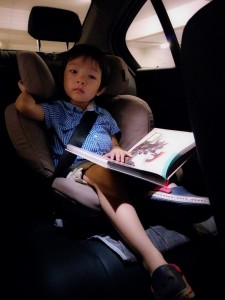Woke up this morning and came across the news of another fatal road accident involving a baby, the tragic end seemingly not unlike the much publicised case that happened a few days ago. According to news reports, in each of these accidents, the baby was thrown clear of the vehicles upon impact.
I loathe to turn this into another one of those 1000-word rants admonishing all and sundry, and I can’t begin to understand why certain drivers do the things they do when they get behind the wheel (to say that driving in KL is but a few notches away from lawlessness isn’t an overstatement). What I will try to do is highlight some facts regarding the law and the use of child seats.
What the law says?
Since 1st January 2012, all new models launched in Malaysia would have come fitted with ISOFIX child seat anchors, not because the car brands collectively decided 2012 as the year to be altruistic, but because the law – laid down by the Ministry of Transport and enforced by the Road Traffic Department – made ISOFIX a mandatory item (among many other regulations) for new cars seeking type approval.
Yet, something doesn’t quite add up. While car manufacturers are mandated to equip new models with ISOFIX child seat anchors, the use of child seats to secure young occupants in a passenger car is however not mandatory. Perhaps it’s time to make it so.
What’s ISOFIX?
Wikipedia has a neatly worded explanation:
ISOFIX is an alternative to securing the seat with seat belts. Seats are secured with a single attachment at the top (top tether) and two attachments at the base of each side of the seat. The full set of anchor points for this system were required in new cars in the United States starting in September 2002.
As mentioned above, ISOFIX is an alternative method of securing a child seat. Yes, older models probably don’t have ISOFIX, which is why it is okay if you’ve been using seat belts to tie down a child seat, but the ISOFIX method greatly reduces the risk of misapplication, e.g. child seat is loose and has too much movement. It overcomes this by utilizing latches which are then directly anchored to the “hooks” on a car’s body.
The brand of car seat which I use for my five-year-old have a page on their website explaining the pros and cons between the two different methods. Click this link to read about it. It’s not a paid endorsement, just good information.
What should you do?
Until the day when the usage of car seats is made mandatory, the choice remains with you, the consumer. It was clear to me from the beginning, my little boy has never gotten into a car without first being secured in a child seat. The ritual began from the day when we brought him home as a newborn, and it won’t end till he’s tall enough to be properly protected by seat belts that are designed to fit adults. In many other countries, including our neighbour Singapore, the law mandates the use of child seats, and parents are even barred by the hospital from bringing home their newborn without showing proof of owning a child seat.
And it’s easy too, as our video shows. Attaching an ISOFIX-type child seat to a mainstream hatch-back took no more than 30 seconds, and belting up a five-year-old, another 30. I’m sure you have a minute to spare for the most precious thing in your life.